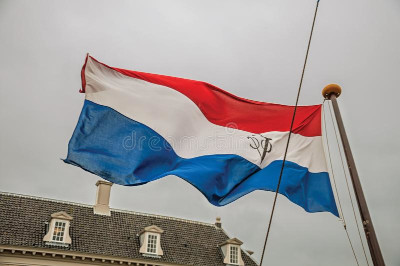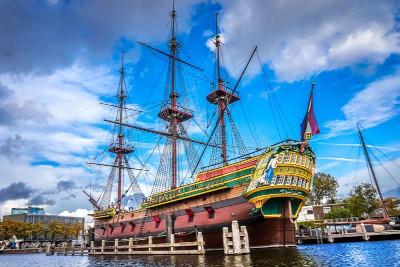What many people do not know is that the Netherlands is a small European country that is actually one of the richest and most important economic centers in Europe. The surprising success of the Dutch is invariably tied to one company, which was arguably the largest and most successful in history. Namely the United East India Company or also known as the VOC (Verenigde Oost-Indische Compagnie).
Establishment

At the end of the 16th century, merchants in the Dutch Republic got the chance to import pepper and spices from Asia. Previously, Portugal had a virtual monopoly on the spice grade. That is why the Netherlands always imported its spices from Portugal. However, when Spain and Portugal got in a war, the Spanish close off the city ‘Lisbon’ to the Dutch Merchants. Suddenly the main artery of the Dutch economy had been cut of. As a result of that they had to sail to the far East and build their own trading network.
In the first six years, the Dutch merchants searched for routes to the Far East. Pre-companies arose that undertook expeditions to Asia. Ships were rented or bought for an expedition and people on board were recruited. After the expedition, the balance was drawn up, the ship was sold and the personnel was made redundant. From the profit on profit a new expedition could be set up. The whole procedure then started all over again. They sent a total of 65 ships, but 10 percent never made it. So it was actually very dangerous to be a merchant at the time. While looking for possible routes, they gained knowledge and experience that they could use in the future. The purpose of those expeditions wasn’t their financial result, but just to show that it was possible to sail to Asia. However, it was really hard to reach their goal because at the same time Spain, Portugal and England were also trying to create their own trading network.
Great strides were made in these six years. Nevertheless, this growth was jeopardized when there was heavy competition between the Zeeland and Amsterdam front companies. This made it easier for Portugal to maintain and strengthen its trading network. For political and economic reasons, the Grand Pensionary of Holland (Johan van Oldebarnevelt) and the stadtholder (Prince Maurtis) finally decided that all merchants should work together. This resulted in the establishment of the Dutch East India Company (VOC) on March 20, 1602. The VOC had several advantages, namely a monopoly trade, the ability to train its own army, to negotiate and declare war, to occupy land and to enforce slavery. Now they had their masterplan to reach their goal and start their own trading network, but how were they supposed to accomplish this?
They came up with an ingenious solution. They build a trading house in Amsterdam and every Dutch citizen could go there and buy share of the company, effectively giving the VOC money in exchange for a claim on its profits in the future. Despite of the fact that they made this masterplan, the republic was still half occupied by Spain. However, the circumstances were more favorable, because the Spanish Empire was at war with England (1585-1604). This gives the Netherlands more space to do things, because Spain was busy with other things.
Organization
The VOC had a monopoly in Asia, which the VOC had received from the States General. The States General was the governing body of all the provinces of the Netherlands at that time. Because of this, all the countries in Asia were not allowed to trade with other countries. The VOC was also allowed to decide for itself how much it paid for the goods they bought in Asia. Naturally, the local population in Asia did not agree with this. Nonetheless, the VOC had come up with a solution for this. The VOC offered them a trade contract. For example, it stated that if the local population sold items to the VOC, the VOC would offer them protection against other countries.
Despite the fact that the local population had a trade contract with the VOC, they sometimes still sold goods to other countries. However, when the VOC found out, they punished the local population by destroying the plantations. Besides the fact that the local population could no longer trade, they also had no food themselves. Through the States General, the VOC had much more right than just trade. The VOC was allowed to build fortresses, conclude agreements with the princes and wage war. This was very special since the VOC was just a company, and could therefore exercise a lot of power.

The VOC soon grew into the largest trading company in the world at that time. The company traded with various countries: East Africa, West Africa, South Africa, Java, Middle East, North West India, South West, India, South India, South Ceylon, Middle Ceylon, Peninsula Jaffna, South Coromandel , North Coromandel , Bengal , Malacca , Indochina , China and Japan. The VOC traded products such as spices, coffee, textiles and porcelain. Every year, two or three fleets sailed from the Republic to Asia. The outward journey took an average of eight months and was not without danger for the sailors as you could read before.
Demise
However, while the ideal combination of circumstances gave the Dutch the chance to become a colonial empire, a number of setbacks at the end of the 18th century saw the destruction of the VOC.
In the 18th century, things went less and less well for the VOC. It could no longer afford its staff, its ships and the maintenance and protection of its establishments. The VOC got a lot of debts, so the VOC seemed to go bankrupt. Judging by the ratio between the profit and the distribution of dividend, the VOC could no longer be saved. The VOC did not modernize, and in retrospect this was a big mistake. At the beginning, the VOC grew quickly, because they were modern for their time. In countries where no one had been before, the VOC found areas where they could get products from. Despite the fact that they did not have to put in much effort, they could become very rich. Due to the VOC’s conservative policy, the company did not keep up with the times. For example, they never started building newer ships, and therefore could not start trading with newer products.
However, when the Netherlands lost to England in 1784 in the fourth Anglo-Dutch War (1780-1784), it was the end of the story for the VOC. After England’s victory, the English merchants managed to halt Dutch trade between Europe and Asia and to take many Dutch trading posts. As no more products arrived in the Netherlands, the company’s debts rose even higher.
On Boxing Day in 1794, almost 200 years after their first expedition, the very last VOC ship sailed away from the roadstead on Texel (Dutch Wadden Island). The next day the English arrived and intercepted and took over the ship. In 1799 on December 31, the VOC was officially declared bankrupt and the State took over the debt of 119 million guilders.
Now that you know more about the United East India Company, you can perhaps imagine why the Netherlands is one of the most important economic centers in Europe. Despite the fact that the VOC made some mistakes (such as not modernizing it) and therefore went down in 1799, the Netherlands is until today still a small but wealthy country.
October 6, 2022
References
- https://en.wikipedia.org/wiki/Dutch_East_India_Company (Wikipedia, 6 October, 2022)
- https://en.wikipedia.org/wiki/Cape_of_Good_Hope (Wikipedia, 6 October, 2022)
- https://isgeschiedenis.nl/nieuws/ontbinding-van-de-verenigde-oost-indische-compagnie (Isgeschiedenis, 6 October, 2022)
- https://kunst-en-cultuur.infonu.nl/geschiedenis/15821-de-ondergang-van-de-verenigde-oost-indische-compagnie.html (Kunst-en-cultuur, 6 October, 2022)
- https://museum.wa.gov.au/explore/dirk-hartog/voc-united-dutch-east-india-company (Museum, 6 October, 2022)
- https://www.britannica.com/topic/Dutch-East-India-Company (The Editors Of Encyclopaedia Britannica, 6 October, 2022)
Pictures
- First picture: Marcello Celli, 6 October, 2022, https://www.dreamstime.com/colorful-dutch-east-india-company-flag-fluttering-cloudy-day-amsterdam-colorful-dutch-east-india-company-flag-fluttering-image106880066
- Second picture: Hpbfotos, 6 October, 2022, https://www.dreamstime.com/full-size-replica-th-century-ship-amsterdam-voc-dutch-east-india-company-built-moored-maritime-museum-image123549300
